It’s a busy Saturday morning in February of 2023 at Hoyt Arboretum, and a group gathers under the Stevens Pavilion for a special event. Today, we are lucky to have Eliza from the Oregon Maple Project come out to teach us how to make maple syrup from our native bigleaf maple.
Eliza and the Oregon Maple Project
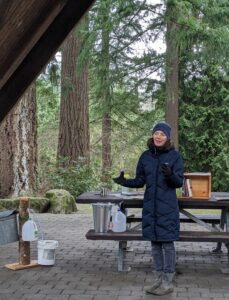

After relocating to Oregon, she spent many years as an elementary school teacher, and reignited her interest in maple sugaring with her students through a special maple unit she taught in class.
In 2020 she transitioned to maple sugaring as a means to environmental education full time through her nonprofit, the Oregon Maple Project.
A Brief History of Maple Sugaring
Bundled up and gathered around the Pavilion’s picnic tables, we learn a brief history of maple sugaring in North America. Most common in the east and midwest, indigenous peoples have been utilizing sap from the sugar maple for an estimated 10,000 years! First encouraged by observing wildlife nibble sapsicles off branch tips, the practice of maple sugaring has persisted from First Food to modern society as a major winter agricultural product in Canada and the eastern parts of the United States.
A long cultural practice honed by traditional knowledge and experience in the east, there isn’t much history of maple sugaring in the western states. Eliza speculates, “This may be because the sugar content of our native maples is much lower, and there are more accessible winter food sources available.”
Sugaring the Bigleaf Maple
The sap collected from sugar maples comes out around 4% sugar content, the rest water (and also minerals). You can drink the sap, but it is not shelf stable as-is. To become syrup, the water must be removed until the sugar content reaches 66%, by boiling, freezing and chucking off the ice, and/or if you’re really fancy- through reverse osmosis!
Bigleaf maples put out sap with 1-2% sugar content, so it takes a lot more bigleaf sap to produce an equal quantity of syrup to sugar maple sap. We measure the bigleaf maple sap collected from the Arboretum with a hydrometer. It reads 1% sugar content.
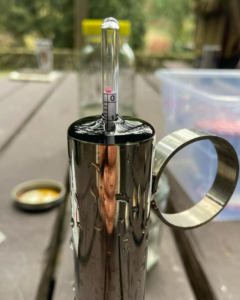

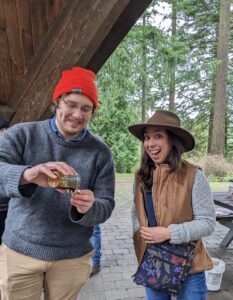

We all sip the sap. It tastes like very lightly sweet water. Then, we sample finished syrup from Oregon Maple Project trees. It’s dark, rich, a little less sweet than sugar maple syrup but with a carmelly depth the other one lacks.
Practicing Sugaring at Hoyt Arboretum
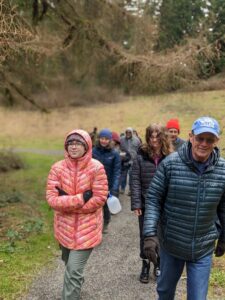

We find young trees, “corpus clumps” or regenerating stems from removed trees, and large bigleafs that must be pushing 200 years old!
Younger trees tend to produce more sap than the great big hundreds-of-years old maples. Eliza thinks this may be because bigger trees have more insulation and thus have less need for the antifreeze-like properties of sap.
We come to a nice 20-30 year old tree off the main trail that split into 2 trunks. Before class, Eliza coordinated with the Arboretum’s Curator to select an appropriate tree to demonstrate tapping on.
We scrape moss from a spot around chest height and drill in about 4 inches. No sap is running from the drill site yet, but it is clean and all the wood shavings are removed. Spiles are hammered into place and the the collection receptacles are connected.
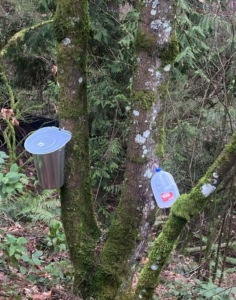

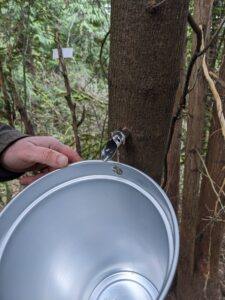

The process is quick and easy, and with a cold snap coming, the promise of flowing sap is high.
Thank You!
Thank you to Eliza for sharing her knowledge, the Arbor Lodge Neighborhood Tree Team for funding and support, and to everyone who came out to learn with us on a chilly day! We can’t wait to do it again next winter!
Important Note About Foraging at Hoyt Arboretum
Foraging – including tree tapping – is not permitted at the Arboretum, but participants will be able to use their new knowledge on their big leaf maples in their backyards.
Sign up for Winter Maple Sugaring Class and Demonstration on February 25, 2023.
